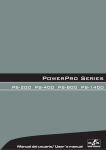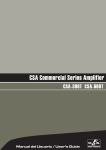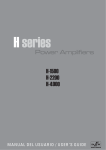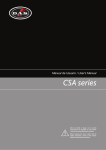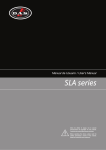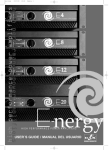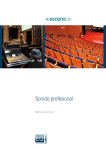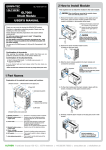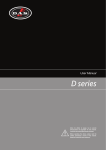Download D.A.S. M-14:2 User`s manual
Transcript
Manual de Usuario / User’s Manual
PS series
Antes de utilizar el equipo, lea la sección
“Precauciones de seguridad” de este manual.
Conserve este manual para futuras consultas.
Before operating the device, please read the
“Safety precautions” section of this manual.
Retain this manual for future reference.
PS
PS series
Precauciones de Seguridad
Safety Precautions
Amplificadores de Potencia / Power Amplifiers
Conserve y lea todas estas instrucciones.
Siga todas las advertencias.
El signo de exclamación dentro de un triángulo indica la
existencia de componentes internos cuyo reemplazo puede
afectar a la seguridad.
Keep these instructions.
Heed all warnings. Follow all instructions.
The exclamation point inside an equilateral triangle indicates the
existence of internal components whose substitution may affect
safety.
Aparato de Clase I.
Class I device.
El signo del rayo con la punta de flecha, alerta contra la
presencia de voltajes peligrosos no aislados. Para reducir el
riesgo de choque eléctrico, no retire la cubierta.
The lightning and arrowhead symbol warns about the presence
of uninsulated dangerous voltage. To reduce the risk of electric
shock, do not remove the cover.
Los signos de rayo cerca de los terminales de salida del
amplificador alertan del riesgo de choque eléctrico en
condiciones normales de uso (terminales peligrosos al tacto). No
toque dichos terminales mientras el amplificador esté encendido.
The lightning and arrowhead symbol near the output terminals of
the amplifier alert of the risk of electric shock in normal
conditions of use (terminal dangerous to the tact). Do not touch
these terminals while the amplifier is working.
El cableado exterior conectado a estos terminales requiere de su
instalación por una persona instruida o el uso de cables flexibles
ya preparados.
The connected outer wiring to these terminals requires of its
installation by an instructed person and the use of a flexible the
cable already prepared.
Este símbolo indica que el presente producto no puede ser
tratado como residuo doméstico normal, sino que debe
entregarse en el correspondiente punto de recogida de equipos
eléctricos y electrónicos.
This symbol on the product indicates that this product should
not be treated as household waste. Instead it shall be handed
over to the appicable collection point for the recycling of
electrical and electronic equipment.
La posición de encendido está indicada en el interruptor
mediante los correspondientes símbolos normalizados (IEC
60417-1:1998 y IEC 60417-2:1998) y dos LEDs verdes
encendidos cerca del interruptor.
The ON position is indicated in the switch by means of the
corresponding standardized symbols (IEC 60417-1:1998 and
IEC 60417-2:1998) and two green LEDs located near the switch.
Si el aparato es conectado permanentemente, la instalación
eléctrica del edificio debe incorporar un interruptor multipolar con
separación de contacto de al menos 3mm en cada polo.
If the apparatus is connected permanently, the electrical system
of the building must incorporate a multipolar switch with a
separation of contact of at least 3mm in each pole.
No exponga este equipo a la lluvia o humedad. No use este
aparato cerca del agua (piscinas y fuentes, por ejemplo). No
exponga el equipo a salpicaduras ni coloque sobre él objetos
que contengan líquidos, tales como vasos y botellas. Equipo IP20.
Do not expose this device to rain or moisture. Do not use this
apparatus near water (for example, swimming pools and
fountains). Do not place any objects containing liquids, such as
bottles or glasses, on the top of the unit. Do not splash liquids
on the unit. IP-20 equipment.
Limpie con un paño seco. No use limpiadores con disolventes.
Clean only with a dry cloth. Do not use any solvent based
No instale el aparato cerca de ninguna fuente de calor como
radiadores, estufas u otros aparatos que produzcan calor. Debe
instalarse siempre sin bloquear la libre circulación de aire a través
de sus rejillas de ventilación. Tenga en cuenta que el aire circula
de la parte posterior a la frontal.
Do not install near any heat sources such as radiators, heat
registers, stoves or other apparatus that produce heat.
The circulation of air on the fan inlet grills must not be blocked.
The air stream circulates from back to front.
Equipo diseñado para funcionar entre 15ºC y 35ºC con una
humedad relativa máxima del 75%.
Working temperature ranges from 15ºC to 35ºC with a relative
humidity of 75%.
Desconecte este aparato durante tormentas eléctricas,
terremotos o cuando no se vaya a emplear durante largos
periodos.
Unplug this apparatus during ligtning storms, earthquakes or
when unused for long periods of time.
Tenga en cuenta que la tensión nominal de alimentación es el
valor indicado en la etiqueta, con un rango ±10% de ese valor
(según IEC 60065:2001).
Take into account that the nominal AC voltage is the value shown
in the equipment ±10% (according to IEC 60065:2001).
Si el cable o enchufe de alimentación está dañado, debe ser
sustituido por un cable o conjunto especial a suministrar por el
fabricante o por su servicio postventa.
If the cable or the mains plug are damaged they must be
replaced. Contact the manufacturer to provide you with the
necessary spare parts.
No existen partes ajustables por el usuario en el interior de este
equipo. Cualquier operación de mantenimiento o reparación
debe ser realizada por personal cualificado. Es necesario el
servicio técnico cuando el aparato se haya dañado de alguna
forma, tal como que haya caído líquido o algún objeto en el
interior del aparato, haya sido expuesto a lluvia o humedad, no
funcione correctamente o haya recibido un golpe.
No user serviceable parts inside. Refer all servicing to qualified
service personnel. Servicing is required when the apparatus has
been damaged in any way, such as power-supply cord or plug is
damaged, liquid has been spilled or objects have fallen into the
apparatus, the apparatus has been exposed to rain or moisture,
does not operate normally or has been dropped.
Manual del Usuario / PS / User’s Manual
GARANTÍA
Todos nuestros productos están garantizados por un periodo de 24
meses desde la fecha de compra.
Las garantías sólo serán válidas si son por un defecto de
fabricación y en ningún caso por un uso incorrecto del producto.
Las reparaciones en garantía pueden ser realizadas,
exclusivamente, por el fabricante o el servicio de asistencia técnica
autorizado.
Otros cargos como portes y seguros, son a cargo del comprador
en todos los casos.
Para solicitar reparación en garantía es imprescindible que el
producto no haya sido previamente manipulado e incluir una
fotocopia de la factura de compra.
WARRANTY
All D.A.S. products are warrantied against any manufacturing defect
for a period of 2 years from date of purchase.
The warranty excludes damage from incorrect use of the product.
All warranty repairs must be exclusively undertaken by the factory
or any of its authorised service centers.
To claim a warranty repair, do not open or intend to repair the
product.
Return the damaged unit, at shippers risk and freight prepaid, to
the nearest service center with a copy of the purchase invoice.
Manual del Usuario / PS / User’s Manual
DECLARACIÓN DE CONFORMIDAD
DECLARATION OF CONFORMITY
D.A.S. Audio, S.A.
C/ Islas Baleares, 24 - 46988 - Pol. Fuente del Jarro - Valencia. España
(Spain).
Declara que la serie PS:
Declares that PS series:
Cumple con los objetivos esenciales de las Directivas:
Abide by essential objectives relating Directives:
l
Directiva de Baja Tensión (Low Voltage Directive)
2006/95/CE
l
Directiva de Compatibilidad Electromagnética (EMC)
2004/108/CE
l
Directiva RoHS
2002/95/CE
l
Directiva RAEE (WEEE)
2002/96/CE
Y es conforme a las siguientes Normas Armonizadas Europeas:
In accordance with Harmonized European Norms:
l
EN 60065:2002
l
EN 55103-1:1996 Electromagnetic compatibility.
Product family standard for audio, video, audiovisual and entertainment lighting control apparatus
for professional use. Part 1:Emission.
l
EN 55103-2:1996 Electromagnetic compatibility.
Product family standard for audio, video, audiovisual and entertainment lighting control apparatus
for professional use. Part 2:Immunity.
Audio, video and similar electronic
apparatus. Safety requirements.
Manual del Usuario / PS / User’s Manual
Manual del Usuario / PS / User’s Manual
ÍNDICE
3
PRESENTACIÓN
Generalidades
Características
DESCRIPCIÓN DEL PANEL FRONTAL
3
Interruptor de encendido
Indicadores de encendido
Controles de nivel
Indicador LED de recorte
Indicador LED de protección
Indicador LED de presencia de señal
Rejillas de ventilación
DESCRIPCIÓN DEL PANEL POSTERIOR
ES
4
Salida de línea de altavoces
Entradas
Conmutador de modo de funcionamiento
Selector de sensibilidad
Interruptor de tierra
Cable de red
Rejillas de entrada de aire
5
INSTALACIÓN
Montaje
Ventilación
Cableado de entrada
Cableado de salida
Conexión a la red eléctrica
Consumos eléctricos
6
USO
Encendido / Apagado
Indicador LED de recorte (clip)
Controles de nivel
ESPECIFICACIONES
7
Í
DIBUJOS DE LÍNEAS
7
APÉNDICE A: Conexiones en modo puente
8
APÉNDICE B: Conexiones de línea: no balanceadas y balanceadas
9
APÉNDICE C: Tablas para la selección del cable
Manual del Usuario / PS / User’s Manual
10
ES
Manual del Usuario / PS / User’s Manual
INTRODUCCIÓN
Indicadores LED de recorte: (D)
Cuando en alguno de los canales la señal supera
la máxima tensión que puede suministrar la fuente de
alimentación del amplificador, el LED rojo de ese
canal se enciende. En este momento el limitador
comienza a actuar corrigiendo el nivel de la señal.
Generalidades
Gracias por adquirir un amplificador D.A.S. Está
construido con la más avanzada tecnología modular y
ha sido diseñado totalmente con sistemas asistidos
por ordenador, tanto sus partes mecánicas como las
electrónicas.
Características
!Clase AB y clase G (sólo en PS-2400).
!Fuente de Alimentación lineal.
!Entradas dobles balanceadas XLR.
!Salidas por bornas y Speakon (sólo en PS-800,
PS-1400 y PS-2400).
!Ventilación forzada con velocidad variable de
atrás hacia delante.
!Control de volumen frontal para cada canal.
!Sensibilidad seleccionable entre 0.775V, 1V y
1.44V.
!Switch anti-bucles de tierra.
!Modo de funcionamiento seleccionable: estéreo,
paralelo o puente.
!Protección total en cada salida amplificada
contra cortocircuitos y contra carga excesiva,
además
de
detectores
de
temperatura
independientes.
!Protección total en la fuente de alimentación
frente a cortocircuito, sobre-tensiones y sobrecorriente, con activación del modo standby.
!Limitación anti-clip.
!Indicadores LED: clip, protección, presencia de
señal y encendido para cada canal.
Indicadores LED de protección: (E)
Cuando la salida de un canal está desactivada por
activarse su protección, este LED amarillo se
enciende.
!Detección de temperatura excesiva en un canal
del amplificador. La salida vuelve a activarse
cuando desaparece el exceso de temperatura. El
circuito de control activado posee una cierta
histéresis para impedir la aparición de oscilaciones
en la conexión y desconexión.
!Detección de corriente continua en la salida de un
canal. Ésta es muy peligrosa para los altavoces y,
por ello, cuando supera cierto umbral, la salida es
desactivada. La salida vuelve a activarse cuando
desaparece la corriente continua.
!Detección de cortocircuito (sólo en PS-200 y PS400) o impedancia anormalmente baja en la salida
de un canal. Si el amplificador está encendido y se
activa esta protección, la salida NO vuelve a
activarse cuando el cortocircuito desaparece, sino
que hay que apagar y encender el amplificador
para que esto ocurra.
DESCRIPCIÓN DEL PANEL FRONTAL
!En el encendido del amplificador. Para evitar que
el transitorio pueda dañar los altavoces y por el
molesto ruido que produce.
PS-200, PS-400
Level A
Clip
Clip
Signal
Signal
On
On
PS-800, PS-1400, PS-2400
G
D
C F B
PowerPro Series
A E
Clip
Clip
Protection
Protection
Signal
Level A
Level B
Protection
Protection
Signal
On
On
Level B
PowerPro Series
G
D C F B
Interruptor de encendido (A)
Pone en funcionamiento el amplificador (posición
"I"), o lo para (posición de apagado marcada como
"0").
Indicadores de encendido: (B)
Cuando estos LED verdes están iluminados nos
indican que ambos canales están preparados para el
uso.
Controles de nivel: (C)
El volumen (ganancia de entrada) de cada canal
puede ser ajustado independientemente por medio de
estos controles. La ganancia máxima se consigue
cuando el potenciómetro rotatorio LEVEL se gira
completamente en sentido horario.
A
E
Indicadores LED de presencia de señal: (F)
Este LED de color verde nos indica la presencia de
señal en las entradas de los canales del amplificador y
son dependientes de la posición de los controles
LEVEL de volumen.
Rejillas de ventilación: (G)
Por ellas se desaloja el aire del interior que se ha
hecho circular por los radiadores de los módulos de
potencia. Debe intentarse siempre que estén libres de
polvo y suciedad, así como procurarse que nada
impida la libre circulación de aire.
Manual del Usuario / PS / User’s Manual
3
ES
DESCRIPCIÓN DEL PANEL POSTERIOR
PS-200, PS-400
HOT
COLD
CH B INPUT
FOR CONTINUED PROTECTION AGAINST RISK OF FIRE, REPLACE ONLY WITH THE SAME FUSE TYPE
C
3
GND
0.775V
CH B
ON
N1918
1
D E
B
CH B INPUT
2
S.N.
GROUND
OFF
G
A
CH B
F
PS-800, PS-1400
BRIDGE
CH A
1.0V
HOT
COLD
STEREO
CH A INPUT
SPEAKER OUTPUT
SENSITIVITY GROUND
1.44V
OFF
GND
PARALLEL
BRIDGE
ON
N1918
FOR CONTINUED PROTECTION AGAINST RISK
OF FIRE REPLACE ONLY WITH THE SAME TYPE
BRIDGE
3
GND
HOT
2
1
CH B
PARALLEL
GND
SENSITIVITY
SPEAKER OUTPUT
1.0V
0.775V
1.44V
CAUTION
RISK OF ELECTRIC SHOCK
DO NOT OPEN
ATTENTION
DANGER D’ELECTROCUTION
NE PAS OUVRIR
WARNING: TO REDUCE RISK OF FIRE OR ELECTRIC SHOCK
DO NOT EXPOSE THIS EQUIPMENT TO RAIN OR MOISTURE
D.A.S. AUDIO S.A. (VALENCIA) SPAIN
MADE IN CHINA
ES
G
VER MANUAL DE INSTRUCCIONES PARA LA CONEXIÓN
REFER TO INSTRUCTIONS MANUAL FOR CONNECTION
ANSCHLUSSWEISE BITTE DER ANLEITUNG ENTNEHMEN
VOIR MANUEL D'INSTRUCTIONS POUR LA CONNEXION
E
B
PS-2400
1+ 1-
COLD
CH A INPUT
CH A
1+ 1CH B
2+ 2BRIDGE 1+ 2+
CH A
HOT
COLD
BRIDGE
MODE STEREO
C
D
F
A
CH B
FOR CONTINUED PROTECTION AGAINST RISK
OF FIRE REPLACE ONLY WITH THE SAME TYPE
CH B INPUT
S.N.
GROUND
OFF
ON
N1918
GND
3
2
HOT
1
CH B
PARALLEL
GND
SENSITIVITY
SPEAKER OUTPUT
1.0V
0.775V
1.44V
CH A
1+ 1CH B
2+ 2BRIDGE 1+ 2+
D.A.S. AUDIO S.A. (VALENCIA) SPAIN
MADE IN CHINA
G
B
E
D
C
Salidas de altavoces (A)
La conexión de altavoces a cada salida se realiza
a través de un par de bornas roja y negra para cada
canal. En PS-800, PS-1400 y PS-2400, también se
dispone de conectores Speakon.
Para las bornas, la polaridad está claramente
indicada: rojo (+) y negro (-).
En el Speakon situado abajo las asignaciones de
pines son:
Canal A : +1 / -1
Canal B : +2 / -2
Puente (bridge) : +1 /+2
En el Speakon situado arriba las asignaciones de
pines son:
Canal B : +1 / -1
Entradas (B)
Se dispone de entradas XLR y Jack en cada canal
del amplificador.
La impedancia nominal de entrada es de 20k
ohmios en modo balanceado y 10k ohmios en modo
no-balanceado.
La polaridad sigue la norma AES14-1992 (ANSI
S4.48-1992):
Pin 1 (XLR) o 'Sleeve' (Jack): GND (Masa)
Pin 2 (XLR) o 'Tip' (Jack): (+) Señal no invertida
Pin 3 (XLR) o 'Ring' (Jack): (-) Señal invertida
Conmutador de modo de funcionamiento (C)
Este conmutador permite elegir entre modo
estéreo, paralelo o puente. El modo estéreo es el
habitual de un amplificador y el que está ajustado por
defecto, de manera que la señal de entrada A
alimenta el canal A y la señal de entrada B el canal B.
4
1+ 1-
COLD
CH A INPUT
CH A
HOT
COLD
BRIDGE
BRIDGE
MODE STEREO
A
F
En modo paralelo se alimentan los dos canales
del amplificador con la señal que le entra al canal
A. La entrada del canal B no quedará
desconectada, por lo que puede usarse para 'link'.
Use el modo puente (bridge) para usar la potencia
de los dos canales en una sola salida. Consulte el
apéndice de utilización en modo puente.
Selector de sensibilidad (D)
Este interruptor permite seleccionar entre tres
posibles valores la sensibilidad del amplificador:
0.775V, 1V y 1.44V.
Interruptor de tierra (E)
Este interruptor se utiliza para evitar bucles de
tierra. Si se detecta el bucle, se pone a 'OFF'.
Cable de red (F)
La conexión del amplificador a la red eléctrica se
realiza a través del conector tipo IEC320-C14. En el
propio conector se encuentra el portafusible y el
fusible correspondiente. Sin embargo, en PS-2400 el
cable no es desmontable.
El cable de conexión a red posee en su interior
tres conductores debidamente aislados, uno de ellos
para la conexión a tierra.
Rejillas de entrada de aire (G)
Como en el caso de las rejas de la parte frontal,
deben estar siempre libres de obstrucción, polvo u
objetos que impidan la libre circulación de aire.
Manual del Usuario / PS / User’s Manual
INSTALACIÓN
Montaje
Los amplificadores están diseñados para
montados en un rack estándar de 19 pulgadas.
altura es de 2 unidades DIN en el caso de PS-800,
1400 y PS-2400, y de 1 unidad DIN en el caso de
200 y PS-400.
ser
Su
PSPS-
Para su montaje dispone de cuatro colisos
(perforaciones alargadas) en la carátula, de los que
puede ser sujeto al rack por tornillos de métrica cinco
o seis. Para evitar la deformación del chasis en
aplicaciones de rack en las que éste sea
transportado, será necesario fijar los amplificadores
utilizando
los
colisos
de
refuerzo
trasero.
Alternativamente, podremos apoyar el amplificador de
abajo contra la base del rack y apilar los
amplificadores sin espacio entre ellos.
Las dimensiones de los amplificadores pueden
encontrarse en la sección “Dibujos de línea”.
Ventilación
Los
amplificadores
están
diseñados de forma que eliminan
el calor de su interior por un
sistema de refrigeración por
ventilación forzada. Disponen de
radiadores de aluminio aireados
por ventiladores colocados en la
parte posterior del amplificador. El
aire circula de la parte posterior a
la frontal.
Cuando se monte en un rack,
no es necesario que éste
disponga de ventilación forzada,
aunque sí es necesario que el rack
no esté cerrado herméticamente.
Debe pues disponer de al
menos
una
rejilla
lo
suficientemente
amplia
que
permita la entrada de aire a su
interior.
Conexión a la red eléctrica
La versión de 230 V AC, tiene una tensión nominal
de funcionamiento de 230 V AC 10%, es decir,
puede funcionar en un rango de tensiones de 207 V a
253 V AC.
De igual forma, en la versión de 115 V AC, es de
115 V AC 10%, o lo que es lo mismo, pueden
funcionar en un rango de tensiones de 103 V a 127 V
AC.
En ambos casos la tensión de funcionamiento
estará indicada en el panel posterior .
Consumos eléctricos
Pueden verse para 230V en la tabla que se
adjunta. Multiplique por 2 para conseguir la corriente a
115V.
Según la norma IEC-60065:2001, el consumo de
corriente en condiciones normales de funcionamiento
es el medido utilizando ruido rosa a 1/8 de potencia
nominal de salida.
Consumos eléctricos / Power consumption (Amperios / Amperes)
PS-200
PS-400
PS-800
PS-1400
PS-2400
Potencia / Power
Max
1/3
1/8
8+8 ohm
4+4 ohm
Puente/bridge
8 ohm
0.87
1.57
1.6
0.31
0.57
0.6
0.15
0.25
0.25
Sin señal
/ idle
0.05
0.05
0.05
8 ohm
1.64
2.98
3.0
0.57
1.06
1.1
0.27
0.47
0.5
0.08
0.08
0.08
8 ohm
2.8
5.28
5.3
0.98
1.82
1.85
0.48
0.81
0.85
0.15
0.15
0.15
8 ohm
5.2
9.59
9.6
1.82
3.41
3.45
0.84
1.48
1.5
0.2
0.2
0.2
8 ohm
12.8
20.1
--20.5
5.9
9.6
--9.6
2.8
4.8
8.5
4.7
0.5
0.5
0.5
0.5
8+8 ohm
4+4 ohm
Puente/bridge
8+8 ohm
4+4 ohm
Puente/bridge
8+8 ohm
4+4 ohm
Puente/bridge
8+8 ohm
4+4 ohm
2+2 ohm
Puente/bridge
Cableado de entrada
El Apéndice sobre cableado de entrada muestra la
conexión balanceada y no-balanceada desde diversos
tipos de conectores.
Cableado de salida
Para la conexión de las salidas se pueden usar las
bornas o bien uno o dos conectores Speakon (sólo
PS-800, PS-1400 y PS-2400). Observe la indicaciones
de la etiqueta.
Se pueden usar las bornas, o bien pelando los
cables de cada cable de altavoz, introduciéndolos por
el orificio de las bornas y apretándolas, o bien
empleando conectores tipo banana. Pele el cable de
forma que permita que el conductor quede oculto.
Observe la polaridad (rojo = +, negro =- ).
Los Speakon proporcionan una conexión y
desconexión rápida para aplicaciones portátiles. Para
activar la conexión se ha de insertar el conector
macho en el hembra y rotar el primero en sentido
horario, quedando bloqueado (sólo PS-800, PS-1400 y
PS-2400).
En los Apéndices se adjunta una tabla para ayudar
en la elección del cable adecuado.
Esto representa la corriente requerida para
reproducir un programa musical típico. La cifra de 1/3
de potencia representa el consumo eléctrico en el
peor caso, mientras que la cifra de máxima potencia
representa el consumo con señal senoidal a máxima
potencia, circunstancia que nunca se produce en la
práctica.
Manual del Usuario / PS / User’s Manual
5
ES
USO
Encendido / apagado
El
interruptor
de
encendido
funcionamiento la etapa.
pone
en
Al accionarlo (posición "|") se encenderán los led
'Protection', pocos segundos después, se producirá
la activación de los canales del amplificador
encendiéndose los led de 'ON' y apagándose los
'Protection' y la etapa estará lista para el
funcionamiento.
ES
El apagado de la etapa se producirá actuando de
nuevo sobre el interruptor de encendido (posición "0").
En este momento desaparecerán las tensiones
principales de alimentación del amplificador más las
tensiones secundarias de funcionamiento.
El encendido de un sistema de sonido ha de
hacerse de atrás hacia delante. Encienda el
amplificador lo último en su sistema de sonido.
Encienda
primero
las
fuentes
tales
como
reproductores de CD o platos giradiscos, luego el
mezclador, después los procesadores y divisores de
frecuencia y finalmente los amplificadores. Si tiene
varios amplificadores evite encenderlos todos a la vez.
Enciéndalos secuencialmente uno a uno o instale un
secuenciador automático de encendido.
Al apagar el sistema de sonido siga el proceso
inverso, y apague los amplificadores antes que
cualquier otro elemento del sistema.
Indicador LED de CLIP
La luz roja del LED de recorte CLIP no debe
permanecer encendida de forma continuada. Esta
situación no perjudica al amplificador, aunque
distorsiona la señal y puede dañar los altavoces. De
hecho, la forma más rápida de quemar la bobina de
un altavoz es recortar (saturar, llevar en clip) de forma
considerable. El amplificador integra una protección
contra el recorte continuado, aunque su eficacia no es
total con señal musical. Por ello se recomienda que si
el amplificador entra en clip lo haga de forma
esporádica, y que el LED de recorte nunca esté
encendido de forma continua.
Controles de nivel
Los controles de nivel LEVEL nos permiten
cambiar la ganancia de entrada de la señal. Aunque
están relacionados con la potencia de salida, no son
una representación directa de ésta. Podemos tener
máxima salida de potencia con estos potenciómetros
a la mitad. De igual manera podemos infrautilizar el
amplificador teniendo los volúmenes al máximo si la
señal de entrada (por ejemplo del mezclador) no es lo
suficientemente fuerte.
Una posibilidad de uso de los controles de
volumen es situarlos en una posición tal que cuando
el mezclador está al máximo, no consigamos que las
luces de CLIP se enciendan o lo hagan sólo muy
ocasionalmente.
6
Manual del Usuario / PS / User’s Manual
ESPECIFICACIONES
Potencia EIA ambos canales / EIA Power, both
channels driven (1 kHz @ 1% THD)
8 ohm, estéreo / stereo
4 ohm, estéreo / stereo
2 ohm, estéreo / stereo
8 ohm, puente / bridge
PS-200
PS-400
PS-800
70 W
100 W
----200 W
140 W
200 W
----400 W
250 W
400 W
----800 W
<0.5%
Distorsion (típica) / Distortion (typical) (20-20k Hz)
Distorsión de Intermodulación / Intermodulation
Distortion
Velocidad de Salto / Rise Time
Respuesta en frecuencia / Frequency Response
PS-1400
PS-2400
450 W
700 W
----1400W
800 W
1200 W
1800 W
2200 W
<0.5%
25 V/us
20Hz - 20kHz +1/-1dB
>100
>90dB
Factor de amortiguamiento / Damping Factor (8 W)
Relación Señal-Ruido / Signal to Noise (20Hz-20kHz)
Crosstalk
Impedancia de entrada / Input Impedance
ES
>60dB
10K Ohm no bal./ unbal., 20K Ohm bal.
Topología / Topology
Clase G /
Class G
Clase AB / Class AB
Peso / Weight
8 kg (17.6 lb)
Dimensiones / Dimensions
10 kg (22.2lb)
13 kg (28.6lb)
27.2 kg (60lb)
16.5 kg (37lb)
Véase sección Dibujos de líneaSee
/ Line Drawings section
DIBUJOS DE LÍNEA
Modelos de 1 unidad DIN de altura (PS-200, PS-400):
44mm [7/4”]
HOT
Level B
Signal
On
On
COLD
CH B INPUT
BRIDGE
Protection
Signal
HOT
COLD
FOR CONTINUED PROTECTION AGAINST RISK OF FIRE, REPLACE ONLY WITH THE SAME FUSE TYPE
482.6mm [19”]
SPEAKER OUTPUT
SENSITIVITY GROUND
1.44V
OFF
GND
STEREO
CH A INPUT
PowerPro Series
BRIDGE
CH A
1.0V
Clip
Clip
Protection
PARALLEL
Level A
33mm [5/4”]
348mm [13 2/3”]
3
GND
2
0.775V
CH B
ON
N1918
1
464mm [18 1/4”]
RISK OF ELECTRIC SHOCK
DO NOT OPEN
DANGER D’ELECTROCUTION
NE PAS OUVRIR
ATTENTION
386mm [15 1/5”]
CAUTION
Modelos de 2 unidades DIN de altura (PS-800, PS-1400, PS-2400):
76.2mm [3”]
CH B INPUT
CH B
88mm [3 ½”]
S.N.
GROUND
OFF
ON
N1918
On
Clip
HOT
COLD
Signal
On
FOR CONTINUED PROTECTION AGAINST RISK
OF FIRE REPLACE ONLY WITH THE SAME TYPE
MODE STEREO
Protection
GND
BRIDGE
3
2
1
HOT
PARALLEL
GND
SENSITIVITY
1.44V
CAUTION
ATTENTION
DANGER D’ELECTROCUTION
NE PAS OUVRIR
WARNING: TO REDUCE RISK OF FIRE OR ELECTRIC SHOCK
DO NOT EXPOSE THIS EQUIPMENT TO RAIN OR MOISTURE
D.A.S. AUDIO S.A. (VALENCIA) SPAIN
MADE IN CHINA
VER MANUAL DE INSTRUCCIONES PARA LA CONEXIÓN
REFER TO INSTRUCTIONS MANUAL FOR CONNECTION
ANSCHLUSSWEISE BITTE DER ANLEITUNG ENTNEHMEN
VOIR MANUEL D'INSTRUCTIONS POUR LA CONNEXION
CH A
1+ 1CH B
2+ 2BRIDGE 1+ 2+
464mm [18 1/4”]
386mm [15 1/5”]
373mm [14 2/3”]
1+ 1-
SPEAKER OUTPUT
1.0V
0.775V
RISK OF ELECTRIC SHOCK
DO NOT OPEN
PowerPro Series
482.6mm [19”]
CH B
COLD
CH A INPUT
Level B
BRIDGE
Signal
CH A
Clip
Protection
Level A
Manual del Usuario / PS / User’s Manual
7
APÉNDICE A. Conexiones en modo puente
El procedimiento para usar el amplificador en modo puente es el siguiente :
1. Apague el amplificador.
2. Baje al mínimo los dos controles de volumen. (Ambos atenuadores girados totalmente en sentido anti-horario).
3. Deberá entrar por la entrada XLR del canal A.
4. Seleccione el modo puente (BRIDGE) de la parte trasera del amplificador.
5. Conecte el altavoz de la siguiente forma : el positivo (+) en borne rojo de salida del canal A y el negativo (-) en
borne rojo de salida del canal B, o en el caso de tener speakon, siga las indicaciones de la etiqueta.
ES
6. Coloque los dos potenciómetros rotatorios de volumen en la posición máxima (ambos atenuadores girados
totalmente en sentido horario).
7.- Deberá manejar el control de atenuación desde el máster exterior al amplificador (por ejemplo desde el
mezclador).
NOTA : No se recomienda la utilización del modo puente en cargas inferiores a 4 ohmios.
8
Manual del Usuario / PS / User’s Manual
APÉNDICE B. Conexiones balanceadas y no balanceadas
Existen dos métodos básicos para transportar la señal de audio:
Línea no-balanceada: Emplea un cable con dos conductores, transportando la señal como diferencia de
potencial (voltaje) entre ambos. El ruido electromagnético (interferencias) del entorno puede sumarse a la señal que
los cables transportan, apareciendo a la salida de nuestro sistema como ruido indeseado. Los conectores que
llevan señal no-balanceada poseen dos pines, tales como el RCA (Phono), y el 1/4” (6.35 mm, comúnmente
llamado jack) mono.
Línea balanceada: Emplea un cable con tres conductores. Uno de ellos sirve de pantalla contra el ruido
electromagnético y es el cable de tierra. Los otros dos tienen la misma tensión respecto del cable de tierra pero con
signos opuestos. El ruido que no pueda ser rechazado por el blindaje afecta por igual a los dos cables que
transportan la señal. La mayor parte de los aparatos electrónicos de audio profesional trabajan con entrada
balanceada. En estos aparatos el circuito de entrada toma la diferencia de potencial entre los dos cables que
transportan la señal con voltajes opuestos, rechazando por tanto el ruido, que tiene el mismo signo en ambos
cables. Los conectores que pueden llevar señal balanceada poseen tres pines, tales como el XLR (Cannon), y el
1/4” (jack) estéreo.
Todas las entradas y salidas de señal de la unidad son balanceadas. Ello permite aprovecharse de la ventajas de
las conexiones balanceadas pero manteniendo la compatibilidad con las no-balanceadas.
Los gráficos que siguen muestran la conexión recomendada desde diferentes tipos de conectores: los
conectores de la izquierda vienen de la fuente de sonido y los de la derecha van a las entradas de la unidad.
Observe que en los conectores no balanceados de la izquierda unimos dos terminales dentro del conector. En las
conexiones de salida balanceada a entrada balanceada, en caso de aparecer zumbidos, pruebe a desconectar la
malla o tierra (sleeve, ground) en el conector de entrada a la unidad. Nótese que los gráficos indican qué pin se
tiene que conectar con qué otro pin, pero que las posiciones de los pines son diferentes a las de un conector XLR
en la realidad. También se asume que los dispositivos usan el pin 2 en el XLR como positivo.
Manual del Usuario / PS / User’s Manual
9
ES
APÉNDICE C. Tabla para la selección del cable
La pérdida de potencia y el factor de amortiguamiento resultante se muestran para varias longitudes y secciones
de cable. Se recomienda un factor de amortiguamiento mínimo de 25, y preferiblemente no inferior a 50 para
instalaciones de calidad. Aunque, por ejemplo una pérdida del 10% de la potencia apenas sea audible, el bajo
factor de amortiguamiento resultante supone que el amplificador tiene poco control sobre el altavoz, que conlleva un
sonido poco claro y con coloración en las frecuencias graves.
LONGITUD /
LENGTH
ES
CALIBRE
AWG (Nr.)
AREA
R (ohm)
PÉRDIDA DE POTENCIA /
POWER LOSS
FACTOR DE
AMORTIGUAMIENTO /
DAMPING FACTOR
8 ohm
4 ohm
8 ohm
4 ohm
18
16
14
12
10
8
0,8 mm2
1,31 mm2
2,1 mm2
3,3 mm2
5,3 mm2
8,35 mm2
0.103
0.066
0.041
0.026
0.016
0.010
1,3 %
0,8 %
0,5 %
0,3 %
0,2 %
0,1 %
2,6 %
1,7 %
1,0 %
0,7 %
0,4 %
0,3 %
61
85
115
147
179
207
30
42
57
73
90
104
5 m (16.4 ft)
18
16
14
12
10
8
0,8 mm2
1,31 mm2
2,1 mm2
3,3 mm2
5,3 mm2
8,35 mm2
0.207
0.131
0.082
0.052
0.033
0.021
2,5 %
1,6 %
1,0 %
0,7 %
0,4 %
0,3 %
5,0 %
3,3 %
2,1 %
1,3 %
0,8 %
0,5 %
34
50
72
99
130
161
17
25
36
50
65
81
7,5 m (24.6 ft)
18
16
14
12
10
8
0,8 mm2
1,31 mm2
2,1 mm2
3,3 mm2
5,3 mm2
8,35 mm2
0.310
0.197
0.123
0.079
0.049
0.031
3,9 %
2,5 %
1,5 %
1,0 %
0,6 %
0,4 %
7,8 %
4,9 %
3,1 %
2,0 %
1,2 %
0,8 %
24
35
53
74
103
134
12
18
26
37
52
67
10 m (33 ft)
18
16
14
12
10
8
0,8 mm2
1,31 mm2
2,1 mm2
3,3 mm2
5,3 mm2
8,35 mm2
0.413
0.262
0.164
0.105
0.066
0.041
5,1 %
3,3 %
2,1 %
1,3 %
0,8 %
0,5 %
10,2 %
6,6 %
4,1 %
2,6 %
1,6 %
1,0 %
18
28
42
60
85
115
9
14
21
30
42
57
15 m (49 ft)
18
16
14
12
10
8
0,8 mm2
1,31 mm2
2,1 mm2
3,3 mm2
5,3 mm2
8,35 mm2
0.620
0.393
0.246
0.157
0.098
0.062
7,8 %
4,9 %
3,1 %
2,0 %
1,2 %
0,8 %
15,6 %
9,8 %
6,2 %
3,9 %
2,5 %
1,6 %
12
19
29
43
63
88
6
9
15
22
31
44
20 m (66 ft)
18
16
14
12
10
8
0,8 mm2
1,31 mm2
2,1 mm2
3,3 mm2
5,3 mm2
8,35 mm2
0.827
0.525
0.328
0.210
0.131
0.082
10,3 %
6,5 %
4,1 %
2,6 %
1,6 %
1,0 %
20,6 %
13,1 %
8,2 %
5,3 %
3,3 %
2,0 %
9
14
22
34
50
72
5
7
11
17
25
36
50 m (164 ft)
16
14
12
10
8
6
1.31 mm2
2.1 mm2
3.3 mm2
5.3 mm2
8.35 mm2
13.3 mm2
1.313
0.820
0.525
0.328
0.205
0.125
16.4 %
7.7 %
4.9 %
3.1 %
1.9 %
1.6 %
32.8 %
15.4 %
9.8 %
6.1 %
3.9 %
3.1 %
6
12
19
29
44
52
3
6
10
15
22
26
75 m (246 ft)
14
12
10
8
6
2.1 mm2
3.3 mm2
5.3 mm2
8.35 mm2
13.3 mm2
1.230
0.788
0.491
0.308
0.186
15.4 %
9.9 %
6.1 %
3.9 %
2.3 %
30.8 %
19.7 %
12.3 %
7.7 %
4.7 %
6
9
15
24
37
3
5
8
12
19
100 m (328 ft)
12
10
8
6
3.3 mm2
5.3 mm2
8.35 mm2
13.3 mm2
1.050
0.655
0.410
0.248
13.1 %
8.2 %
5.1 %
3.1 %
26.3 %
16.4 %
10.2 %
6.2 %
7
12
18
29
4
6
9
14
2,5 m (8.2 ft)
10
Manual del Usuario / PS / User’s Manual
CONTENTS
3
INTRODUCTION
General
Features
FRONT PANEL DESCRIPTION
3
Power switch
Power LED
Input level controls
Clip LED
Protection LED
Signal LED
Cooling air outlet grilles
BACK PANEL DESCRIPTION
4
Speaker outputs
Inputs
Input mode switch
Input sensitivity selector
Ground loop selector
Mains LED
Fan inlet grilles
5
INSTALLATION
Racking
Cooling
Input cable connections
Speaker cable connections
Connetion to mains
Current draw
6
USE
Switch ON/OFF
Clip LED
Level controls
SPECIFICATIONS
7
LINE DRAWINGS
7
APPENDIX A: Bridge mode operation
8
APPENDIX B: Line connections: balanced and un-balanced
9
APPENDIX C: Tables for cable selection
Manual del Usuario / PS / User’s Manual
10
EN
EN
Manual del Usuario / PS / User’s Manual
CLIP LED (D)
In the event that the signal's excursion exceeds the
maximum voltage from the power supply, the unit will
indicate saturation through the clip LED of the channel
involved. An automatic limiting system will impede
prolonged saturation.
INTRODUCTION
General
Thank you for purchasing a D.A.S. power amplifier.
It has been built with the most advanced modular
technology, and has been designed through the use of
computer-aided design for both the electronic and
mechanical parts.
PROTECTION LED (E)
When a channel's output is disconnected by the
amplifier's protection, this yellow LED is on.
A channel's protection may be triggered by:
Features
!Class AB (except PS-2400, which is class G).
!Linear power supply.
!Dual balanced XLR inputs.
!Binding post and Speakon output connections
(PS-800, PS-1400 and PS-2400 only).
!Variable speed back-to front fan cooling.
!Front located volume controls.
!Input sensitivity switchable between 0.775V, 1V
and 1.44V.
!Ground anti-loop selector.
!Stereo, parallel and mono operation modes.
!Complete and independent protections on each
channel against output short-circuits, overloading
and overheating.
!The power supply is protected against shortcircuits, voltgae and current overloading; triggering
the latter to the standby mode.
!Clip limiters.
!Clip, protection and idle LED indicators.
!Overheating sensed at any part of a channel.
When the amplifier has cooled down, the
channel's output will be connected and operation
will resume. The control circuit has some degree of
built-in hysterisis to avoid turn-on and off
oscillations.
!Presence of DC at a channel's output. Since it
may severely damage speakers, the amplifier will
deactivate the output in the event that DC levels
are too high. Once DC is no longer present, the
PROTECTION LED will turn off and output is
reactivated.
!Short-circuit at a channel's output (only PS-200
and PS-400) or load impedance is too low this
protection is activated. In this case, once the short
circuit is gone the output is NOT reactivated; the
amplifier needs to be switched off and on to
reactivate.
!When the amplifier is switched on. The output is
also deactivated for a few seconds to prevent
dangerous transients from damaging the speakers.
FRONT PANEL DESCRIPTION
PS-200, PS-400
Level A
Clip
Clip
Signal
Signal
On
On
PS-800, PS-1400, PS-2400
G
D
C F B
PowerPro Series
A E
Clip
Clip
Protection
Protection
Signal
Level A
Level B
Protection
Protection
Signal
On
On
Level B
PowerPro Series
EN
G
D C F B
Power switch (A)
Turns the amplifier on(" I " position), and turns the
amplifier off ( " 0 " position).
A
E
SIGNAL LED(F)
These green LEDs show the presence of signal at
the amplifier's inputs, and is dependent on the
position of the LEVEL control.
Power LED: ON (B)
When these green LEDs illuminate, it indicates that
both amplifier channels are ready.
Input LEVEL controls (C)
Volume levels for each channel can be adjusted by
using the knobs found on the front panel. Gain is
maximum when the LEVEL rotary potentiometer is
rotated fully clockwise.
Cooling air outlet grilles (G)
Fan cooling permits airflow through the most vital
parts of the amplifier. Since the airflow finds its way
out through these grilles, keep them as clean and
dust-free as possible to assure proper cooling.
Manual del Usuario / PS / User’s Manual
3
REAR PANEL DESCRIPTION
PS-200, PS-400
HOT
COLD
CH B INPUT
FOR CONTINUED PROTECTION AGAINST RISK OF FIRE, REPLACE ONLY WITH THE SAME FUSE TYPE
C
3
GND
0.775V
CH B
ON
N1918
1
D E
B
CH B INPUT
2
S.N.
GROUND
OFF
G
A
CH B
F
PS-800, PS-1400
BRIDGE
CH A
1.0V
HOT
COLD
STEREO
CH A INPUT
SPEAKER OUTPUT
SENSITIVITY GROUND
1.44V
OFF
GND
PARALLEL
BRIDGE
ON
N1918
FOR CONTINUED PROTECTION AGAINST RISK
OF FIRE REPLACE ONLY WITH THE SAME TYPE
BRIDGE
3
GND
HOT
2
1
CH B
PARALLEL
GND
SENSITIVITY
SPEAKER OUTPUT
1.0V
0.775V
1.44V
CAUTION
RISK OF ELECTRIC SHOCK
DO NOT OPEN
ATTENTION
DANGER D’ELECTROCUTION
NE PAS OUVRIR
WARNING: TO REDUCE RISK OF FIRE OR ELECTRIC SHOCK
DO NOT EXPOSE THIS EQUIPMENT TO RAIN OR MOISTURE
D.A.S. AUDIO S.A. (VALENCIA) SPAIN
MADE IN CHINA
G
VER MANUAL DE INSTRUCCIONES PARA LA CONEXIÓN
REFER TO INSTRUCTIONS MANUAL FOR CONNECTION
ANSCHLUSSWEISE BITTE DER ANLEITUNG ENTNEHMEN
VOIR MANUEL D'INSTRUCTIONS POUR LA CONNEXION
E
B
PS-2400
1+ 1-
COLD
CH A INPUT
CH A
1+ 1CH B
2+ 2BRIDGE 1+ 2+
CH A
HOT
COLD
BRIDGE
MODE STEREO
C
D
F
A
CH B
FOR CONTINUED PROTECTION AGAINST RISK
OF FIRE REPLACE ONLY WITH THE SAME TYPE
CH B INPUT
S.N.
GROUND
OFF
ON
N1918
GND
3
2
HOT
1
CH B
PARALLEL
GND
SENSITIVITY
SPEAKER OUTPUT
1.0V
0.775V
1.44V
CH A
1+ 1CH B
2+ 2BRIDGE 1+ 2+
D.A.S. AUDIO S.A. (VALENCIA) SPAIN
MADE IN CHINA
G
B
E
D
C
Output connections (A)
Channel output connections to speakers is by
binding posts. PS-800, PS-1400 and PS-2400 models
also provide Speakon NL4 connections.
For the binding posts, polarity is clearly indicated
by black (-) and red (+) output terminals.
For the lower Speakon connector, pin
assignments are:
Channel A : +1 / -1
Channel B : +2 / -2
Bridge :
+1 /+2
For the Speakon situated on top, pin
assignments are:
Channel B : +1 / -1
EN
Inputs (B)
XLR and Jack inputs are connected in parallel.
Nominal input impedance is 20k ohms for
balanced use and 10k ohms for unbalanced use.
Polarity complies with AES14-1992 (ANSI S4.481992):
Pin 1 (XLR) or 'Sleeve' (Jack): GND (Ground).
Pin 2 (XLR) or 'Tip' (Jack): (+) Non-inverted
signal.
Pin 3 (XLR) or 'Ring' (Jack): (-) Inverted signal.
Input mode (C)
This switch allows the selection of the input
configuration mode: stereo, parallel or bridge. Typically
the amplifiers are used in stereo mode, where the
input to channel A feeds channel A and the input to
channel B feeds channel B.
4
1+ 1-
COLD
CH A INPUT
CH A
HOT
COLD
BRIDGE
BRIDGE
MODE STEREO
A
F
Parallel mode allows feeding both channels with
the signal plugged into channel A. Channel B's input
isn't disconnected in this mode, therefore it can be
used as a link thru connection.
Bridge mode sums both amplifier channels
together, thus doubling the output power. Refer to the
“Bridge Mode Operation” Appendix for further
information.
Input sensivity selector (D)
This selector allows to choose the input sensitivity
0.775V, 1.00V and 1.44V.
Ground loop selector (E)
The selector is used to avoid ground loops. Set
the selector in the “OFF” position when loops are
detected.
Mains lead (F)
The mains lead is a connector type IEC320-C14.
The fuse and the fuse-carrier are in the mains
connector.
But, on PS-2400 the power cord cannot be
disassembled.
The power cord is made of three isolated wires, a
wire is for ground connection.
Fan inlet grilles (G)
Like for the front outlet grilles, keep clean and
dust-free to assure free air intake for proper cooling.
Manual del Usuario / PS / User’s Manual
INSTALLATION
Racking
All amplifiers are 19-inch rack mount width. PS-200
and PS-400 are 1U DIN in height. PS-800, PS-1400 and
PS-2400 are 2U DIN in height.
Four front-panel mounting holes are provided for
use with M5 or M6 or 1/4” screws. To avoid bending
the chassis in rack mounting applications where the
rack will be transported, mount the amplifiers to the
back of the rack using the rear mounting holes.
Alternatively, place the bottom amplifier against the
base of the rack and pile the amplifiers with no
clearance in between.
Amplifier’s dimensions can be found on the “Line
Drawings” section of this manual.
Cooling
A fan cools the aluminium heat
sinks from back to front.
Fan cooling permits airflow
through the most vital parts of the
amplifier.
When mounting the unit onto a
19-inch rack, a rack cooling
system is not required, since the
air is exhausted out through the
front grille.
Be sure your unit has the nominal AC voltage for
your country.
Power consumption
Can be seen on the accompanying table for 230V.
Double the ratings to get the 115V current
consumption.
Standard
IEC-60065:2001
specify
AC
consumption using pink noise at 1/8th of rated power.
This is done to represent the current requirements to
reproduce a typical musical programme.
Consumos eléctricos / Power consumption (Amperios / Amperes)
PS-200
PS-400
PS-800
PS-1400
However, the rack must not be
sealed, and it should at least have
a large enough ventilation grille to
allow air into the rack.
Connection to mains
Nominal AC voltage will always be indicated on the
back panel. 230V and 115V versions are available.
Nominal AC voltage range on 230V version, is
230V ±10%, that meaning it can work from 207V up
to 253V.
Likewise, on the 115V version, the nominal AC
voltage range is 115V ±10%, that meaning it can work
from 103V up to 127V.
PS-2400
Potencia / Power
Max
1/3
1/8
8+8 ohm
4+4 ohm
Puente/bridge
8 ohm
0.87
1.57
1.6
0.31
0.57
0.6
0.15
0.25
0.25
Sin señal
/ idle
0.05
0.05
0.05
8 ohm
1.64
2.98
3.0
0.57
1.06
1.1
0.27
0.47
0.5
0.08
0.08
0.08
8 ohm
2.8
5.28
5.3
0.98
1.82
1.85
0.48
0.81
0.85
0.15
0.15
0.15
8 ohm
5.2
9.59
9.6
1.82
3.41
3.45
0.84
1.48
1.5
0.2
0.2
0.2
8 ohm
12.8
20.1
--20.5
5.9
9.6
--9.6
2.8
4.8
8.5
4.7
0.5
0.5
0.5
0.5
8+8 ohm
4+4 ohm
Puente/bridge
8+8 ohm
4+4 ohm
Puente/bridge
8+8 ohm
4+4 ohm
Puente/bridge
8+8 ohm
4+4 ohm
2+2 ohm
Puente/bridge
Input cable connections
The Input Cabling Appendix shows balanced and
unbalanced connection from different types of
connector to the amplifiers.
The 1/3rd power rating represents a worst case
scenario, while the maximum power represents
consumption with sine wave signal, which will never
occur in practice.
Speaker cable connections
Either the binding posts or the Speakon
connectors (PS-800,PS-1400 and PS-2400) can be
used.
EN
The binding posts can be used with bare wire or
banana connectors. In either case, ensure that you
remove the required length of cable sleeve that allows
for the conductor itself to be hidden. Always note
polarity (red=+,black=–).
Speakon connectors offer quick connection for
portable applications. To enable a Speakon
connection, plug the male connector into the outlet
and rotate it clockwise. It will then lock into place and
be ready for use.
The Appendices of this manual include a table to
aid in the selection of the appropriate cable gauge.
Manual del Usuario / PS / User’s Manual
5
USE
Switch ON / OFF
The main power switch turns the amplifier on.
When the power switch is turned On ("|" position)
the PROTECTION LED illuminates. After approximately
7 seconds the main power supply voltage will be
turned on internally and the ON LEDs will illuminate.
Then the PROTECTION LED will go out and the
amplifier will be ready to be used.
To turn the amplifier off push the power switch ("0"
position). At that moment the main power supply
voltage and the secondary power supply voltage will
turn off internally.
Switch your sound system on from back to front.
Thus, switch on the amplifiers last on your sound
system. Switch sound sources (CDs, turntables) first,
then your mixer, then your processors and crossovers
and finally the amplifiers. If you have more than one
amplifier, switch them on sequentially, one at a time or
use a sequencer.
Follow the reverse order when switching off, and
switch off the amplifiers before any other element on
your sound system.
CLIP LED
The clip LED should never be on continuously. This
will distort the signal and may damage the speakers.
In fact, severe clipping is an easy way of burning a
speaker's voice coil.
The amplifiers feature an automatic limiting system
that impedes prolonged saturation, but the dynamic
nature of music signals stops it from being a brick wall
protection. Thus at most, the clip light could be lit
occasionally.
EN
LEVEL Controls
The LEVEL rotary potentiometer is used for
changing the input gain. Although related to output
power, it is not a direct representation of it. Thus, we
can have maximum output power with the gain at mid
position. Similarly, we may have the gain controls at
maximum and not have maximum output if our source
signal is not strong enough.
One way to use the volume controls is to set them
such that when the mixer's faders are at their
maximum level, we are just below clipping level on the
amplifier or clipping very occasionally.
6
Manual del Usuario / PS / User’s Manual
SPECIFICATIONS
Potencia EIA ambos canales / EIA Power, both
channels driven (1 kHz @ 1% THD)
8 ohm, estéreo / stereo
4 ohm, estéreo / stereo
2 ohm, estéreo / stereo
8 ohm, puente / bridge
PS-200
PS-400
PS-800
70 W
100 W
----200 W
140 W
200 W
----400 W
250 W
400 W
----800 W
<0.5%
Distorsion (típica) / Distortion (typical) (20-20k Hz)
Distorsión de Intermodulación / Intermodulation
Distortion
Velocidad de Salto / Rise Time
Respuesta en frecuencia / Frequency Response
PS-1400
PS-2400
450 W
700 W
----1400W
800 W
1200 W
1800 W
2200 W
<0.5%
25 V/us
20Hz - 20kHz +1/-1dB
>100
>90dB
Factor de amortiguamiento / Damping Factor (8 W)
Relación Señal-Ruido / Signal to Noise (20Hz-20kHz)
Crosstalk
Impedancia de entrada / Input Impedance
>60dB
10K Ohm no bal./ unbal., 20K Ohm bal.
Topología / Topology
Clase G /
Class G
Clase AB / Class AB
Peso / Weight
8 kg (17.6 lb)
Dimensiones / Dimensions
10 kg (22.2lb)
13 kg (28.6lb)
27.2 kg (60lb)
16.5 kg (37lb)
Véase sección Dibujos de líneaSee
/ Line Drawings section
LINE DRAWINGS
PS-200, PS-400:
44mm [7/4”]
HOT
Level B
Signal
On
On
COLD
CH B INPUT
BRIDGE
Protection
Signal
HOT
COLD
FOR CONTINUED PROTECTION AGAINST RISK OF FIRE, REPLACE ONLY WITH THE SAME FUSE TYPE
482.6mm [19”]
SPEAKER OUTPUT
SENSITIVITY GROUND
1.44V
OFF
GND
STEREO
CH A INPUT
PowerPro Series
BRIDGE
CH A
1.0V
Clip
Clip
Protection
PARALLEL
Level A
33mm [5/4”]
348mm [13 2/3”]
3
GND
2
0.775V
CH B
ON
N1918
1
464mm [18 1/4”]
RISK OF ELECTRIC SHOCK
DO NOT OPEN
DANGER D’ELECTROCUTION
NE PAS OUVRIR
ATTENTION
386mm [15 1/5”]
CAUTION
PS-800, PS-1400, PS-2400:
76.2mm [3”]
CH B INPUT
S.N.
GROUND
OFF
ON
N1918
On
Clip
HOT
COLD
Signal
On
FOR CONTINUED PROTECTION AGAINST RISK
OF FIRE REPLACE ONLY WITH THE SAME TYPE
MODE STEREO
Protection
GND
BRIDGE
3
2
1
HOT
PARALLEL
GND
SENSITIVITY
1.44V
RISK OF ELECTRIC SHOCK
DO NOT OPEN
PowerPro Series
ATTENTION
DANGER D’ELECTROCUTION
NE PAS OUVRIR
WARNING: TO REDUCE RISK OF FIRE OR ELECTRIC SHOCK
DO NOT EXPOSE THIS EQUIPMENT TO RAIN OR MOISTURE
D.A.S. AUDIO S.A. (VALENCIA) SPAIN
MADE IN CHINA
VER MANUAL DE INSTRUCCIONES PARA LA CONEXIÓN
REFER TO INSTRUCTIONS MANUAL FOR CONNECTION
ANSCHLUSSWEISE BITTE DER ANLEITUNG ENTNEHMEN
VOIR MANUEL D'INSTRUCTIONS POUR LA CONNEXION
CH A
1+ 1CH B
2+ 2BRIDGE 1+ 2+
464mm [18 1/4”]
386mm [15 1/5”]
373mm [14 2/3”]
1+ 1-
SPEAKER OUTPUT
1.0V
0.775V
CAUTION
482.6mm [19”]
CH B
COLD
CH A INPUT
Level B
BRIDGE
Signal
CH A
Clip
Protection
Level A
EN
CH B
88mm [3 ½”]
Manual del Usuario / PS / User’s Manual
7
APPENDIX A. Bridge Mode Operation
To operate in bridge mode, follow these steps:
1.Switch off the amplifier.
2.Turn volume control potentiometers on the front panel to minimum position (fully anticlockwise).
3.Connect input signal to channel A.
4.Set mode switch to “BRIDGE”.
5.Connect speakers as follows:
Connect (+) to red speaker terminal on channel A's output terminals
Connect (-) to red speaker terminal on channel B's output terminals
6. Turn volume control potentiometers on the front panel to maximum position (fully clockwise).
7. Control volume levels from the mixer or pre-amp only.
NOTE: We do not recommend using bridge mode with loads lower than 4 ohms.
EN
8
Manual del Usuario / PS / User’s Manual
APPENDIX B. Unbalanced and balanced connections
There are two basic ways to transport an audio signal:
Unbalanced line: Utilising a two-conductor cable, it transports the signal as the voltage between them. Electromagnetic interference can get added to the signal as undesired noise. Connectors that carry unbalanced signals
have two pins, such as RCA (Phono) and 1/4” (6.35 mm, often referred to as jack) mono. 3-pin connector such as
XLR (Cannon) may also carry unbalanced signals if one of the pins is unused.
Balanced line: Utilising a three-conductor cable, one of them acts as a shield against electro-magnetic noise and
is the ground conductor. The other two have the same voltage with respect to the ground conductor but with
opposite signs. The noise that cannot be rejected by the shield affects both signal conductors in the same way. At
the device's input the two signals get summed with opposite sign, so that noise is cancelled out while the
programme signal doubles in level. Most professional audio devices use balanced inputs and outputs. Connectors
that can carry balanced signal have three pins, such as XLR (Cannon) and 1/4” (6.35 mm) stereo.
The graphs that follow show the recommended connection with different types of connectors to balanced
processor or amplifier inputs. The connectors on the left-hand side come from a signal source, and the ones on the
right hand side go to the inputs of the processor or amplifier. Note that on the unbalanced connectors on the lefthand side, two terminals are joined inside the connector. If hum occurs with balanced to balanced connections, try
disconnecting the sleeve (ground) on the input connector. Note that the illustrations show what should be connected
to what, but that pin locations on an actual XLR connector are different. Also, pin 2 hot is assumed on XLR
connectors.
EN
Manual del Usuario / PS / User’s Manual
9
APPENDIX C. Table for cable selection
The table below is intended to aid the selection of the appropriate cable. Power loss and resulting damping
factor are shown for different values of cable length and area. A minimum damping factor of 25 is recommended,
preferably not lower than 50 for quality installations. Although a power loss of 10% may not be significantly audible,
the resulting low damping factor means that the amplifier will not be able to control the loudspeaker, resulting in a
coloured and muddy bass sound.
LONGITUD /
LENGTH
CALIBRE
AWG (Nr.)
AREA
R (ohm)
PÉRDIDA DE POTENCIA /
POWER LOSS
FACTOR DE
AMORTIGUAMIENTO /
DAMPING FACTOR
8 ohm
4 ohm
8 ohm
4 ohm
18
16
14
12
10
8
0,8 mm2
1,31 mm2
2,1 mm2
3,3 mm2
5,3 mm2
8,35 mm2
0.103
0.066
0.041
0.026
0.016
0.010
1,3 %
0,8 %
0,5 %
0,3 %
0,2 %
0,1 %
2,6 %
1,7 %
1,0 %
0,7 %
0,4 %
0,3 %
61
85
115
147
179
207
30
42
57
73
90
104
5 m (16.4 ft)
18
16
14
12
10
8
0,8 mm2
1,31 mm2
2,1 mm2
3,3 mm2
5,3 mm2
8,35 mm2
0.207
0.131
0.082
0.052
0.033
0.021
2,5 %
1,6 %
1,0 %
0,7 %
0,4 %
0,3 %
5,0 %
3,3 %
2,1 %
1,3 %
0,8 %
0,5 %
34
50
72
99
130
161
17
25
36
50
65
81
7,5 m (24.6 ft)
18
16
14
12
10
8
0,8 mm2
1,31 mm2
2,1 mm2
3,3 mm2
5,3 mm2
8,35 mm2
0.310
0.197
0.123
0.079
0.049
0.031
3,9 %
2,5 %
1,5 %
1,0 %
0,6 %
0,4 %
7,8 %
4,9 %
3,1 %
2,0 %
1,2 %
0,8 %
24
35
53
74
103
134
12
18
26
37
52
67
10 m (33 ft)
18
16
14
12
10
8
0,8 mm2
1,31 mm2
2,1 mm2
3,3 mm2
5,3 mm2
8,35 mm2
0.413
0.262
0.164
0.105
0.066
0.041
5,1 %
3,3 %
2,1 %
1,3 %
0,8 %
0,5 %
10,2 %
6,6 %
4,1 %
2,6 %
1,6 %
1,0 %
18
28
42
60
85
115
9
14
21
30
42
57
15 m (49 ft)
18
16
14
12
10
8
0,8 mm2
1,31 mm2
2,1 mm2
3,3 mm2
5,3 mm2
8,35 mm2
0.620
0.393
0.246
0.157
0.098
0.062
7,8 %
4,9 %
3,1 %
2,0 %
1,2 %
0,8 %
15,6 %
9,8 %
6,2 %
3,9 %
2,5 %
1,6 %
12
19
29
43
63
88
6
9
15
22
31
44
20 m (66 ft)
18
16
14
12
10
8
0,8 mm2
1,31 mm2
2,1 mm2
3,3 mm2
5,3 mm2
8,35 mm2
0.827
0.525
0.328
0.210
0.131
0.082
10,3 %
6,5 %
4,1 %
2,6 %
1,6 %
1,0 %
20,6 %
13,1 %
8,2 %
5,3 %
3,3 %
2,0 %
9
14
22
34
50
72
5
7
11
17
25
36
50 m (164 ft)
16
14
12
10
8
6
1.31 mm2
2.1 mm2
3.3 mm2
5.3 mm2
8.35 mm2
13.3 mm2
1.313
0.820
0.525
0.328
0.205
0.125
16.4 %
7.7 %
4.9 %
3.1 %
1.9 %
1.6 %
32.8 %
15.4 %
9.8 %
6.1 %
3.9 %
3.1 %
6
12
19
29
44
52
3
6
10
15
22
26
75 m (246 ft)
14
12
10
8
6
2.1 mm2
3.3 mm2
5.3 mm2
8.35 mm2
13.3 mm2
1.230
0.788
0.491
0.308
0.186
15.4 %
9.9 %
6.1 %
3.9 %
2.3 %
30.8 %
19.7 %
12.3 %
7.7 %
4.7 %
6
9
15
24
37
3
5
8
12
19
100 m (328 ft)
12
10
8
6
3.3 mm2
5.3 mm2
8.35 mm2
13.3 mm2
1.050
0.655
0.410
0.248
13.1 %
8.2 %
5.1 %
3.1 %
26.3 %
16.4 %
10.2 %
6.2 %
7
12
18
29
4
6
9
14
2,5 m (8.2 ft)
EN
10
Manual del Usuario / PS / User’s Manual
UM_PS_01
www.dasaudio.com
D.A.S. AUDIO, S.A.
C/. Islas Baleares, 24
46988 Fuente del Jarro
Valencia, SPAIN
Tel. 96 134 0525
Tel. Intl. +34 96 134 0860
Fax 96 134 0607
Fax Intl. +34 96 134 0607
D.A.S. AUDIO OF AMERICA, INC.
Sunset Palmetto Park
6816 NW 77th Court.
Miami, FL. 33166 - U.S.A.
TOLL FREE: 1-888DAS4USA
Tel. +1 305 436 0521
Fax +1 305 436 0528
D.A.S. AUDIO ASIA PTE. LTD.
25 Kaki Bukit Crescent #01-00/02-00
Kaki Bukit Techpark 1
Singapore 416256
Tel. +65 6742 0151
Fax +65 6742 0157




























